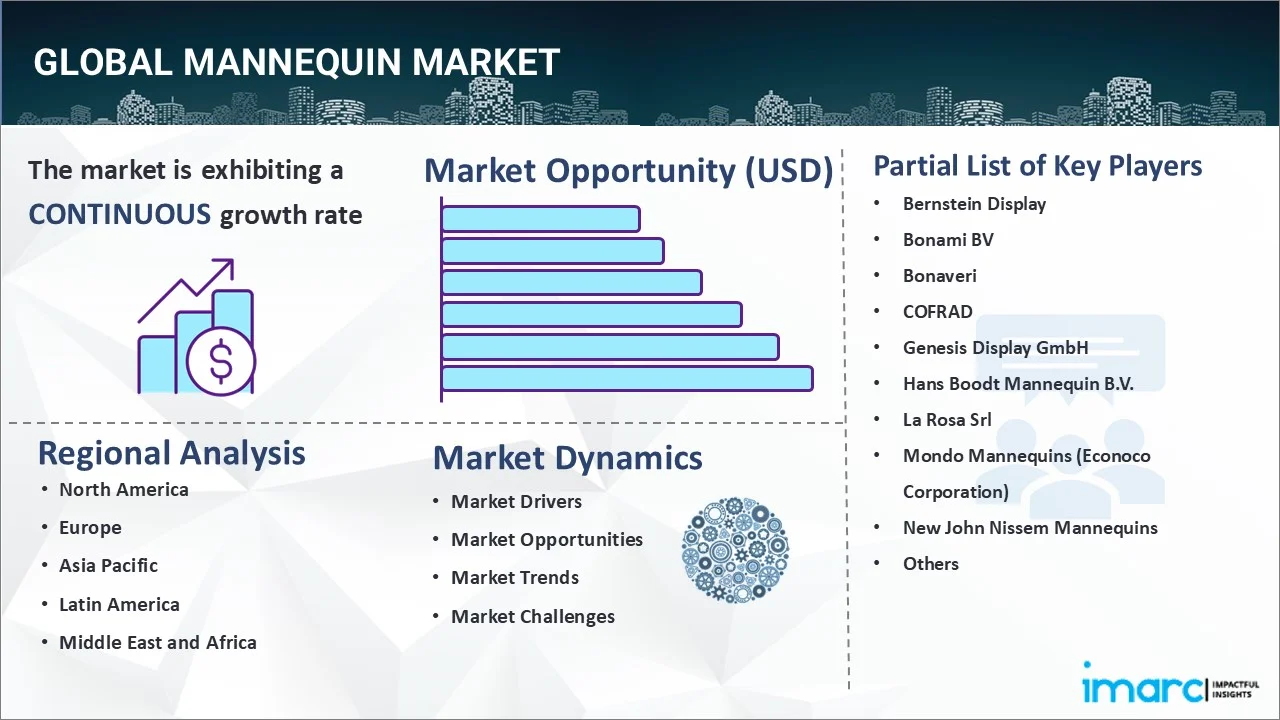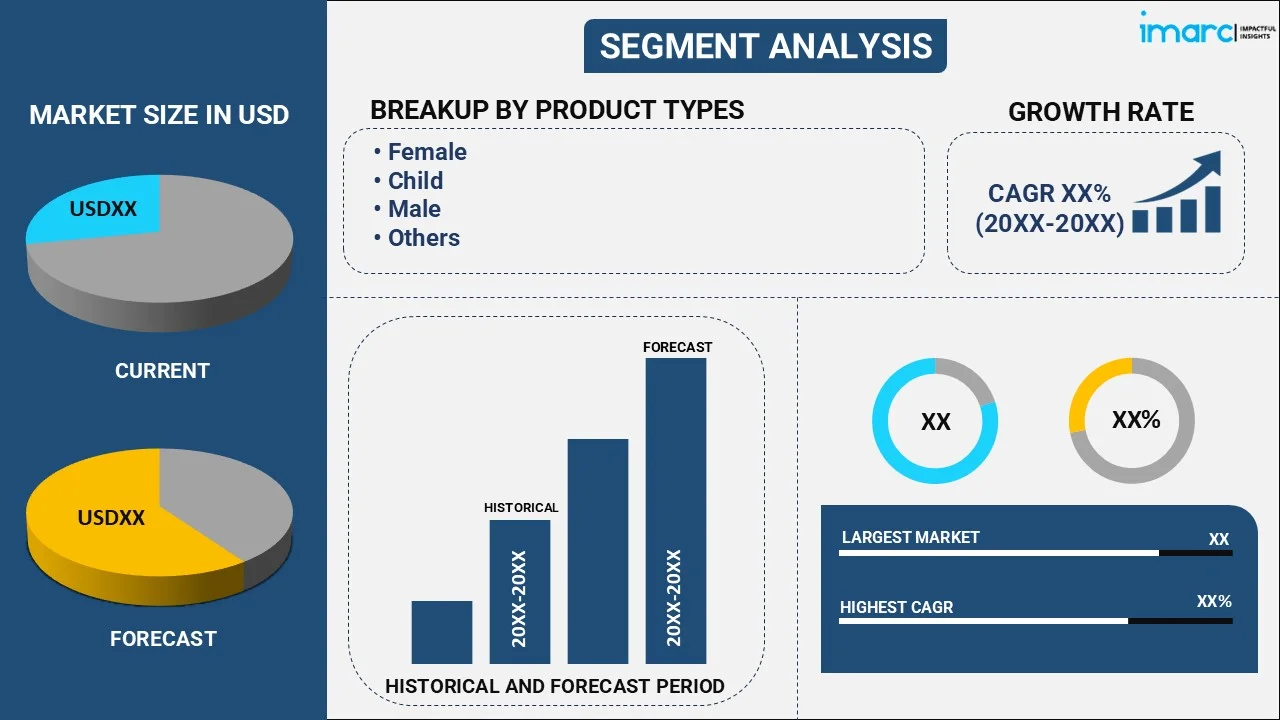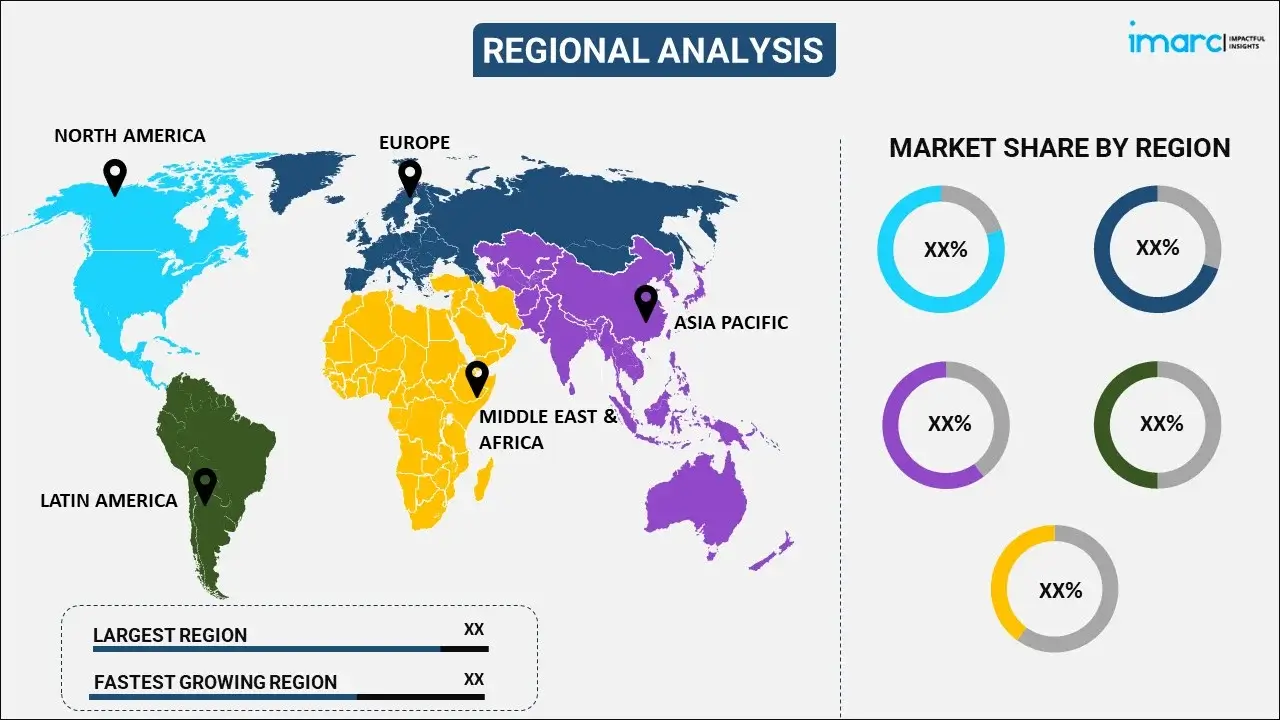
Mannequin Market Report by Product Type (Female, Child, Male, and Others), Material (Fiberglass, Plastic, and Others), Application (Cosmetic Industry, Jewelry Industry, Garment Industries, Medical and Healthcare Industry, and Others), and Region 2025-2033
Market Overview:
The global mannequin market size reached USD 5.4 Billion in 2024. Looking forward, IMARC Group expects the market to reach USD 6.9 Billion by 2033, exhibiting a growth rate (CAGR) of 2.76% during 2025-2033. The constantly evolving fashion industry, increasing emphasis on visual merchandising and store aesthetics, rapid growth of the e-commerce industry, and advancements in technology to develop mannequins with adjustable body shapes, realistic textures, and interactive elements are some factors propelling the market.
|
Report Attribute
|
Key Statistics
|
|---|---|
|
Base Year
|
2024 |
|
Forecast Years
|
2025-2033
|
|
Historical Years
|
2019-2024
|
| Market Size in 2024 | USD 5.4 Billion |
| Market Forecast in 2033 | USD 6.9 Billion |
| Market Growth Rate (2025-2033) | 2.76% |
A mannequin is a three-dimensional model or replica used to display clothing, accessories, or other items in a visually appealing manner. It is typically made of plastic, wood, or fiberglass materials to resemble the human body and often features adjustable limbs and detachable parts for ease of dressing. It serves as a valuable tool for showcasing fashion trends, helping customers envision how clothing would look on a person, and highlighting the desired fit and style. Mannequin is found in retail stores, fashion exhibitions and museums, playing a significant role in visual merchandising and conveying the intended aesthetic and appeal of a brand or product.

The fashion industry plays a significant role in propelling the mannequin market. As fashion trends evolve, retailers require mannequins to effectively display their latest collections and attract customers. Mannequins allow retailers to showcase clothing in a visually appealing and realistic manner, aiding customers in visualizing how garments would look on themselves. Additionally, the increasing emphasis on visual merchandising and store aesthetics has boosted the demand for mannequins. Retailers recognize the importance of creating an immersive and captivating customer shopping experience. Well-designed and strategically positioned mannequins can enhance the overall ambiance of a store and draw attention to specific products, ultimately accelerating sales. Other than this, the growth of e-commerce has also influenced the mannequin market. Online retailers utilize virtual mannequins or digital models to showcase their products. These digital representations simulate the appearance and fit of clothing on a virtual body, providing customers with a better understanding of the product and aiding their purchasing decisions. Moreover, the mannequin market is driven by advancements in technology. Manufacturers are incorporating innovative features such as adjustable body shapes, realistic textures, and interactive elements, allowing retailers to customize and adapt their displays according to their target audience and brand image.
Mannequin Market Trends/Drivers:
Constantly evolving fashion trends
Constantly evolving fashion trends propel the mannequin market by driving the need for updated and relevant displays. As fashion trends change, retailers strive to stay current and appeal to their target audience. Mannequins play a vital role in showcasing the latest styles and capturing the essence of these trends. Retailers rely on mannequins to effectively communicate the desired aesthetic, fit, and styling of clothing to customers. By regularly updating their mannequin displays to reflect the latest fashion trends, retailers create an immersive shopping experience that resonates with consumers, thus driving sales and maintaining their competitive edge in the fashion industry.
Increasing emphasis on visual merchandising and store aesthetics
The increasing emphasis on visual merchandising and store aesthetics drives the mannequin market by creating a demand for visually captivating displays. Retailers recognize the power of creating an appealing shopping environment that attracts customers and enhances their overall experience. Mannequins play a crucial role in this aspect, as they allow retailers to showcase their products in a visually pleasing and realistic manner. Well-designed mannequins effectively communicate the brand's image, highlight specific products, and create a cohesive and engaging store ambiance. By investing in quality mannequins and utilizing them strategically, retailers can elevate their visual merchandising efforts and create a strong brand identity that resonates with customers, ultimately accelerating sales and customer loyalty.
Growth of e-commerce
The rapid growth of e-commerce propels the mannequin market by increasing the demand for virtual mannequins or digital models. As more consumers shop online, retailers recognize the need to provide a realistic representation of their products. Virtual mannequins simulate the appearance and fit of clothing on a virtual body, allowing customers to better visualize how the garment would look on themselves. This technology bridges the gap between the physical shopping experience and online shopping, boosting customer confidence and aiding their purchasing decisions. As a result, retailers are investing in virtual mannequin solutions, driving the demand for digital modeling technologies and contributing to the growth of the mannequin market.
Mannequin Industry Segmentation:
IMARC Group provides an analysis of the key trends in each segment of the global mannequin market report, along with forecasts at the global, regional, and country levels from 2025-2033. Our report has categorized the market based on the product type, material, and application
Breakup by Product Type:

- Female
- Child
- Male
- Others
Female mannequins are the most popular product type
The report has provided a detailed breakup and analysis of the mannequin market based on the product type. This includes female, child, male, and others. According to the report, female mannequin represented the largest segment.
Females play a significant role in driving the mannequin market for several reasons. For instance, the fashion and retail industries primarily target female consumers for women's clothing, accessories, and other products. Therefore, the demand for female mannequins to display these products is high as they are essential tools for showcasing clothing and accessories. Additionally, the demand for diverse body types and sizes in mannequins arises from the need to cater to the diverse female customer base and promote inclusivity. Besides this, female shoppers heavily influence purchasing decisions, and mannequins help create visual displays that resonate with their preferences and aspirations. The fashion industry's emphasis on aesthetics and trends, which are often driven by female consumers, further fuels the demand for innovative and stylish mannequins to attract and engage female shoppers.
Breakup by Material:
- Fiberglass
- Plastic
- Others
Fiberglass hold the majority of the overall market share
The report has provided a detailed breakup and analysis of the mannequin market based on the material. This includes fiberglass, plastic and others. According to the report, fiberglass accounted for the largest market share.
Fiberglass is propelling the mannequin market due to its unique characteristics and advantages. Fiberglass mannequins offer durability, lightweight construction, and the ability to achieve intricate details and poses. The material is highly versatile, allowing for customization in terms of color, finish, and texture, catering to the ever-changing trends in the fashion industry. Fiberglass mannequins are also resistant to damage during transportation, assembly, disassembly, and daily use in retail settings, making them a long-lasting investment for retailers. Furthermore, fiberglass offers a cost-effective solution compared to other materials like wood or plastic. Its versatility, durability, and cost-effectiveness have contributed to the growing popularity of fiberglass mannequins, thus escalating their demand in the mannequin industry. Also, fiberglass mannequins offer a high degree of realism and can be finely sculpted and painted to achieve a more life-like appearance, which makes them ideal for creating appealing displays and effectively showcasing products.
Breakup by Application:
- Cosmetic Industry
- Jewelry Industry
- Garment Industries
- Medical and Healthcare Industry
- Others
A detailed breakup and analysis of the mannequin market based on the application has also been provided in the report. This includes cosmetic, jewelry, garment, medical and healthcare, and other industries.
Cosmetic companies sometimes use mannequin heads or faces to demonstrate how their products look when applied. These can be full heads or just parts of a face to showcase hair, eyelash or eyebrow products.
Mannequins in the jewelry industry are utilized to display accessories like necklaces or pendants, earrings, rings, bracelets, and watches to help shoppers visualize how the items might look when worn.
In the garment industry, fashion designers often use mannequins when creating and tailoring clothing. They provide a three-dimensional form for draping and fitting garments during the design process.
Medical and healthcare training programs often use mannequins for simulation purposes. They are used to teach a variety of medical procedures, from basic first aid to complex surgeries. These mannequins can have a range of features, from simple anatomical representations to sophisticated models that can simulate a wide range of physiological conditions.
Breakup by Region:

- North America
- United States
- Canada
- Europe
- Germany
- France
- United Kingdom
- Italy
- Spain
- Others
- Asia Pacific
- China
- Japan
- India
- South Korea
- Australia
- Indonesia
- Others
- Latin America
- Brazil
- Mexico
- Others
- Middle East and Africa
North America exhibits a clear dominance, accounting for the largest mannequin market share
The report has also provided a comprehensive analysis of all the major regional markets, which include North America (the United States and Canada); Europe (Germany, France, the United Kingdom, Italy, Spain, and others); Asia Pacific (China, Japan, India, South Korea, Australia, Indonesia, and others); Latin America (Brazil, Mexico, and others); and the Middle East and Africa. According to the report, North America was the largest market for mannequins.
North America region has a robust and thriving retail industry, with a significant number of fashion brands, department stores, and boutiques. These businesses heavily rely on mannequins to showcase their clothing and create visually appealing displays. Besides this, North America sets trends and influences fashion globally, making it a crucial market for innovative and stylish mannequins that reflect the latest fashion aesthetics. Other than this, the demand for diverse representation and inclusivity in visual merchandising drives the need for a wide range of mannequin types and body forms. North America's prominent position in the retail and fashion industry continues to drive the growth of the mannequin market in the region.
Competitive Landscape:
The key players are focusing on innovation and technology advancements. Manufacturers are investing in research and development to introduce new materials, realistic textures, and interactive features in mannequins, enhancing their visual appeal and functionality. This attracts retailers who seek modern and eye-catching displays for their products. Additionally, they
are offering customizable mannequins with adjustable body shapes, poses, and detachable parts, allowing retailers to create unique and tailored displays that align with their brand image and target audience. Other than this, key players are actively collaborating with fashion brands and retailers to work closely with stakeholders to understand their specific display needs and develop mannequins that align with the latest fashion trends. Moreover, they are expanding their global presence by establishing partnerships and distribution networks. This enables them to reach a wider customer base and cater to the growing demand for mannequins in various regions.
The report has provided a comprehensive analysis of the competitive landscape in the global mannequin market. Detailed profiles of all major companies have also been provided. Some of the key players in the market include:
- Bernstein Display
- Bonami BV
- Bonaveri
- COFRAD
- Genesis Display GmbH
- Hans Boodt Mannequin B.V.
- La Rosa Srl
- Mondo Mannequins (Econoco Corporation)
- New John Nissem Mannequins
- NoaBrands
- Retailment A/S
- Window France
Recent Developments:
- Bersntein Display introduced eco-friendly mannequins, made from sustainable materials, such as recycled plastics, and natural fibers.
- NoaBrands started producing 100% recyclable mannequins that can be fully reprocessed and turned into new products once the mannequin reaches the end of its life. This reduces waste and the need for new materials, which can have significant environmental benefits.
- Genesis Display GmbH produced BIONICV, mannequins made of viscose fibers with bio-resin that are flexible, durable, and impact-resistant.
Mannequin Market Report Scope:
| Report Features | Details |
|---|---|
| Base Year of the Analysis | 2024 |
| Historical Period | 2019-2024 |
| Forecast Period | 2025-2033 |
| Units | Billion USD |
| Scope of the Report | Exploration of Historical and Forecast Trends, Industry Catalysts and Challenges, Segment-Wise Historical and Predictive Market Assessment:
|
| Product Types Covered | Female, Child, Male, Others |
| Materials Covered | Fiberglass, Plastic, Others |
| Applications Covered | Cosmetic Industry, Jewelry Industry, Garment Industries, Medical and Healthcare Industry, Others |
| Regions Covered | Asia Pacific, Europe, North America, Latin America, Middle East and Africa |
| Countries Covered | United States, Canada, Germany, France, United Kingdom, Italy, Spain, China, Japan, India, South Korea, Australia, Indonesia, Brazil, Mexico |
| Companies Covered | Bernstein Display, Bonami BV, Bonaveri, COFRAD, Genesis Display GmbH, Hans Boodt Mannequins B.V., La Rosa Srl, Mondo Mannequins (Econoco Corporation), New John Nissen Mannequins, NoaBrands, Retailment A/S, Window France |
| Customization Scope | 10% Free Customization |
| Post-Sale Analyst Support | 10-12 Weeks |
| Delivery Format | PDF and Excel through Email (We can also provide the editable version of the report in PPT/Word format on special request) |
Key Questions Answered in This Report:
- How has the global mannequin market performed so far, and how will it perform in the coming years?
- What are the drivers, restraints, and opportunities in the global mannequin market?
- What is the impact of each driver, restraint, and opportunity on the global mannequin market?
- What are the key regional markets?
- Which countries represent the most attractive mannequin market?
- What is the breakup of the market based on the product type?
- Which is the most attractive product type in the mannequin market?
- What is the breakup of the market based on the material?
- Which is the most attractive material in the mannequin market?
- What is the breakup of the market based on the application?
- Which is the most attractive application in the mannequin market?
- What is the competitive structure of the global mannequin market?
- Who are the key players/companies in the global mannequin market?
Key Benefits for Stakeholders:
- IMARC’s report offers a comprehensive quantitative analysis of various market segments, historical and current market trends, market forecasts, and dynamics of the mannequin market from 2019-2033.
- The research study provides the latest information on the market drivers, challenges, and opportunities in the global mannequin market.
- The study maps the leading, as well as the fastest-growing, regional markets. It further enables stakeholders to identify the key country-level markets within each region.
- Porter's five forces analysis assist stakeholders in assessing the impact of new entrants, competitive rivalry, supplier power, buyer power, and the threat of substitution. It helps stakeholders to analyze the level of competition within the mannequin industry and its attractiveness.
- Competitive landscape allows stakeholders to understand their competitive environment and provides an insight into the current positions of key players in the market.
Need more help?
- Speak to our experienced analysts for insights on the current market scenarios.
- Include additional segments and countries to customize the report as per your requirement.
- Gain an unparalleled competitive advantage in your domain by understanding how to utilize the report and positively impacting your operations and revenue.
- For further assistance, please connect with our analysts.
 Request Customization
Request Customization
 Speak to an Analyst
Speak to an Analyst
 Request Brochure
Request Brochure
 Inquire Before Buying
Inquire Before Buying




.webp)




.webp)












